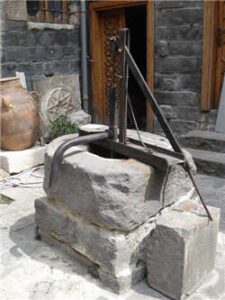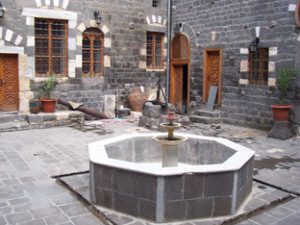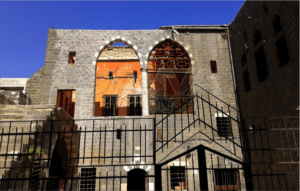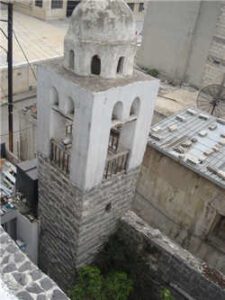Al-Zahrawi Palace
Al-Zahrawi Palace
It is one of the ancient houses of Homs located in the Al-Hamidiyah neighborhood. Its construction dates back to the Mamluk era. The palace was named after the family that resided and settled in it. It was used as a ruling house in Homs after the castle of Osama. This is evidenced by the design of the building and its military fortifications, which consists of two main sections:
the first:
It is called “The Great House” and includes three wings: the North, the East, and the West.
This dates back to the Mamluk era (13th century AD), and the building foundation plate says that its builder is Ali ibn Abi al-Fadl al-Azhari.
Second:
It is known as the “Palace” and includes the southern section that dates back to the Ottoman era (late 18th century AD and early 19th century), built by Ahmed Abu Al-Ma’ali Al-Qadi.
Another building was attached to the palace in the eastern part of it, in which Sheikh Musa bin Zahra established a zawiya and his own mosque. The last addition to the palace is the western annex built by Abdul Qadir Al-Zahrawi.
When we visit the palace, we see that it consists of a two-storey square building overlooking the courtyard, whose southern corner is the iwan, then the doors of the rooms are distributed on the rest of the sides of the courtyard.
Above the main gate of the palace is an arch with a three-lobed arch. This gate was closed when the western section of the palace collapsed, and a water fountain was built in its place and replaced by the current entrance to the left of the main gate.
Rich architectural traditions are evident in the palace that clearly shows the multiplicity of construction stages in the palace, and on different historical eras. The Persian influence is evident in the arches based on the walls that meet at the top to form a large arch. The Ayyubid muqarnas and the Mamluk decoration, and on one of the palace walls we find an inscription dating back to the Umayyad period.
We also note the presence of a Mamluk emblem belonging to King Al-Zahir Baybars, his famous motto (the seventy facing each other), which was engraved on a stone and placed on the northern facade of the palace courtyard.
One of the most beautiful works of art in the palace is the ceiling of the iwan, with its muqarnas decorated with precision and creativity, which takes the shape of an oval, where the ceiling arches rest on the walls.
Due to the importance of this archaeological edifice, it was acquired by the General Directorate of Antiquities and Museums on December 30, 1976 in order to transform it into a museum of folklore.
حمص - الحميدية





